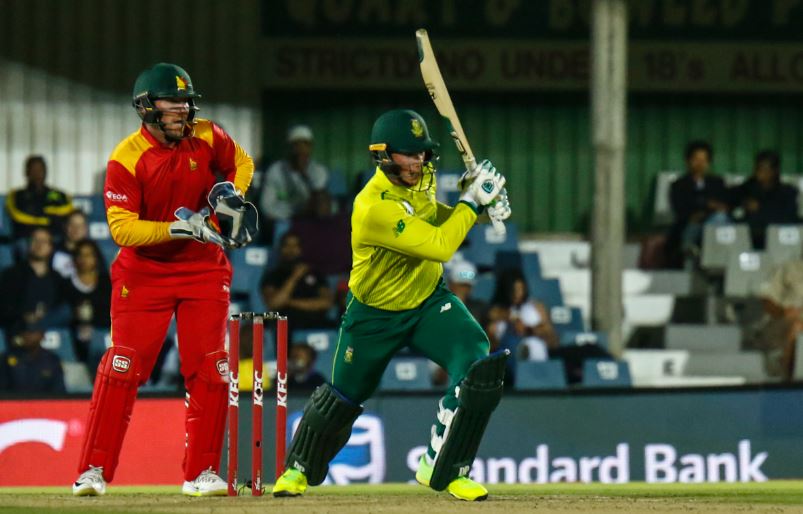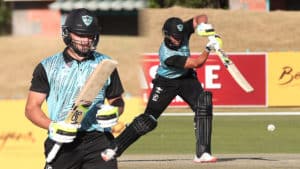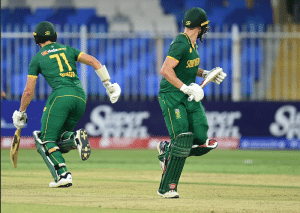The strong reaction to the Proteas’ loss in the first ODI to Pakistan at St George’s Park is no doubt due to raised public expectations following the 3-0 Test series win, but the public has overlooked what went right in PE, writes SIMON LEWIS.
The one area I do think the Proteas erred was in their bowling lineup for St George’s – the Proteas bowled just 13 overs of slow stuff at a return of 2-57 and an economy rate of 4.38 runs per over, which is a full run lower than Pakistan’s innings run rate of 5.43.
Pakistan had four turners to call on, and combined they returned 1-108 off 22 overs at an economy rate of 4.91, which was less than half a run cheaper than the Proteas’ innings rate of 5.32. The over-reliance on pace on all surfaces is likely the reason in chief for the PE loss, because while the Proteas batted steadily against the slow stuff and Pakistan’s medium pace, they found it hard to get them away to rack up big overs. Pakistan, on the other hand, used the pace of the Proteas to hit four key boundaries in the last handful of overs.
READ ALSO: Proteas need to adapt – Faf
While the Proteas need to play to their strength (pace bowling), they do need the variation of a second full-time spinner in their one-day lineup, but selected without consideration for his batting ability. Batsmen must score runs – bowlers take wickets and keep the runs down.
1) Pakistan won in the last over
At St George’s Park, Mohammad Hafeez scored a superb 71 not out off 63 balls to guide his side home in the last over. As South Africans, we love to claim that ‘anything they can do we can do better’, and while that’s a great attitude for keeping our game at the highest level, it is important to analyse such performances in context. Although 266 is not the greatest total to defend in 50-over cricket, it’s certainly not a disaster, as it still gave the Proteas bowlers something to defend – and they almost succeeded.
READ ALSO: Pakistan outclass Proteas
The fact that Pakistan needed to bat into the last over speaks volumes for the bowling attack. This is important in a World Cup context, because even if the Proteas fail to deliver with the bat, the bowlers can still win the World Cup as long as there is a half-decent score on the board.
2) The Proteas played the wicket
The focus seems to be on Hashim Amla and Rassie van der Dussen batting slowly, but it wasn’t a fast track loaded with easy runs. Babar Azam is a really talented and effective young batsman, yet his 49 came off 69 balls.
Imam-ul-Haq scored a fine 86 off 101 balls, which is in keeping with his ODI strike rate. The difference maker was Hafeez, the wily 38-year-old who has played 204 ODIs, which is 34 more than the Proteas’ current most experienced player, Amla (170 ODIs) and 79 more than number two on the Proteas’ list, Faf du Plessis (125 ODIs).
Reeza Hendricks was slow off the mark at a strike rate of 67.17, which can happen to batsmen, but he made an effort to force the pace at the cost of his wicket. One match in which the players don’t nail the run rate is not a disaster in the context of a five-match series. Being bowled out for 150 or even 200 would have been a disaster, but a five-wicket loss in the last over should be water off a duck’s back.
3) Pakistan won with a late flurry
Pakistan pulled off their win thanks to a late flurry of runs, and all credit to them for it. However, a late flurry of runs carries with it the potential for the result to go either way, and although professional cricket is a results-oriented business, one needs to cut the players some slack. The balance shifted Pakistan’s way on the day – with just five balls to spare – so take it on the chin and move on to the next contest.
One thing to remember, however, is how tight it all was. Yes, Pakistan had played themselves into a strong position by keeping their scoring rate around 5.50 an over through their entire run chase … but the lethal Proteas bowling attack kept the squeeze on in the final 10 overs.
READ ALSO: Proteas squeeze out 266
While one must credit Pakistan for their win, one shouldn’t be too hard on the Proteas, as they gave a good account of themselves and made Pakistan work hard for the win.
Final overs countdown (Pakistan innings)
Over 40 – 2 runs
Over 41 – 9 runs
Over 42 – 5 runs, 1 wicket
Over 43 – 2 runs, 1 wicket
Over 44 – 3 runs
Over 45 – 6 runs
Over 46 – 5 runs
Over 47 – 10 runs
Over 48 – 4 runs
Over 49 – 13 runs
Over 50 – 1 run (1 ball bowled)
Hafeez scored five of the last six boundaries and it was his measured approach to punish any bad balls that took his side home. For their part, the Proteas did superbly to bowl six of their last 10 overs for less than six runs an over, and that shouldn’t be forgotten in an analysis of the match.
4) It’s not about the win
The Proteas won the Test series, but they now find themselves 1-0 down in a five-match ODI series. Quinton de Kock and Dale Steyn are both rested. It’s simply an ODI series which forms part of the side’s way to World Cup glory – its greatest importance lies in the opportunities it affords the Proteas to prepare for the World Cup.
Of course, you never want to get into a habit of losing, but leading up to the World Cup I’d certainly take a few losses if the team is benefiting from quality ‘match practice’. What good would it have done if Van der Dussen had gone out for 50 or 60 because he felt he needed to push the pace?
READ ALSO: ODI series vs Pakistan a ‘nice challenge’ – Faf
The Proteas’ middle order would arguably have made it to 300 if given a handful of overs to get stuck into the Pakistan attack, but I would rather lose the match and see two key top-order batsmen benefit from the chance to compile a big score each. A scrappy, win-at-all-costs victory (with all due respect to white ball cricket) would be forgotten within a few days, but the legacy of confidence and self-belief that will follow the 155-run second-wicket stand between Amla and Van der Dussen could prove to be more important than any ODI win.
Let’s look again on 14 July 2019!
5a) Amla found form
Amla’s ton was ‘slow’ in the context of what fans hoped to see as a total, but what people forget is the micro-battles. Amla is walking a tightrope that stretches from his cricketing legacy all the way through to the waiting World Cup in England – he didn’t score an international century in 2018, and neither has he scored an international century against a Top 6 opponent since 2016.
WATCH: Amla’s game is all about balance
Amla needed to grind his way to that ton, put in the hard yards, push the singles, secure the century. He needed it for himself, but he also needed to reassure the selectors and fans that their talisman still has what it takes. South Africa has a rich supplyvof talented batsmen waiting to take their place in the side, but Amla’s ability and experience is going to play a monster role in the Proteas winning the World Cup (or not).
He hasn’t had an easy time in recent years and is on the cusp of retirement, so for that last big push to the World Cup he needs every ounce of belief he can muster. Regardless of how he might be playing in the nets or feeling about his game, top batsmen need to score centuries.
Mission accomplished on that score. Now to observe just how that St George’s Park innings will inspire his form for the next six months. Fingers and toes crossed.
5b) Rassie enjoyed a great debut
Rassie van der Dussen (‘VDD’) scored 56 on his T20I debut for the Proteas against Zimbabwe last year, and stepped into the world of ODI cricket (after leading the T20 run-scoring in the inaugural MSL) with a superb inning of 93. Judging by the expectations of the public and media, however, it was expected that VDD should have no trouble revisiting his T20 form from November-December, and then translating it into his ODI debut in mid-January.
People forget that time has passed since the MSL, and a players’ form goes through ups and downs. They forget that the players have gone from T20 mode to red-ball mode for two 4-Day matches … and now they have to jump into 50-over mode. While they are well-trained pros who have the capability to juggle the formats well, they’re still not robots. Sometimes the ball just doesn’t come off the bat that well, or off the wicket.
READ ALSO: Why Van der Dussen is so good

VDD is a few days away from turning 30 and has made his long-awaited ODI debut just a handful of matches in advance of the announcement of the World Cup squad – so it was effectively a one-off chance for him to show that he has more than just a 50 in his kit bag and can, indeed, push on to three figures.
Currently, there are too many players in the Proteas side who are averaging in the 20s and 30s in ODIs, and there is an urgent need for players to be given a run who can push through the good and bad times to score 80s, 90s, 120s. Rapid 20s and 30s look great in the highlights package, but they won’t cut the mustard in what is going to be a pretty open and highly competitive World Cup in England.
Photo: Richard Huggard/Gallo Images/Getty Images





